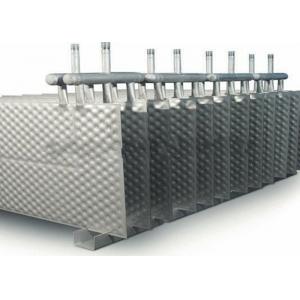

Add to Cart
Pillow Plate Hot Selling High Power Single Double Embossed Profile
Water Pressure Inflatable Specific Cooling Heating
Description
Pillow plate heat exchangers are a class of fully welded heat
exchanger design, which exhibit a wavy, “pillow-shaped” surface
formed by an inflation process. Compared to more conventional
equipment, such as shell and tube and plate and frame heat
exchangers, pillow plates are a quite young technology. Due to
their geometric flexibility, they are used as well as “plate-type”
heat exchangers and as jackets for cooling or heating of vessels.
Pillow plate equipment is currently experiencing increased
attention and implementation in process industry.
Construction
Pillow plates are manufactured by an inflation process, where two
thin metal sheets are spot-welded to each other over the entire
surface by laser or resistance welding. The sides of the plates are sealed by seam welding, other than
the connecting ports. Finally, the gap between the thin metal
sheets is pressurized by a hydraulic fluid causing a plastic
forming of the plates, which eventually leads to their
characteristic wavy surface.
In principle, there are two different types of pillow plates:
single-embossed and double-embossed. The former commonly form the
double walls of jacketed vessels, while the latter are assembled to a stack (bank) to manufacture
pillow plate heat exchangers. Single-embossed pillow plates are
formed when the base plate is significantly thicker than the top
plate. The thinner top plate deforms, while the base plate remains
plane.
Furthermore, pillow plates are commonly equipped with “baffle” seam weldings, which offer a targeted flow guidance in the pillow plate channels in cases, where flow distribution or fluid velocity might be an issue. A method for obtaining flow guidance by baffles in the channels between adjacent pillow plates in pillow plate heat exchangers, has recently been proposed in.
Due to their construction, pillow plates are hermetically sealed,
they have a high structural stability and their manufacturing is
mostly automated and highly flexible. Pillow plates can be operated
at pressures > 100 MPa and temperatures of up to 800 °C.
Technical Parameters
| Product Name | Pillow plate heat exchanger |
| Material | Stainless Steel |
| Color | Nickel White |
| Standard | DIN GB ISO JIS BA ANSI ASMI |
| Grade | SUS201,SUS304,SUS316,DSS2205 |
| Overview double pillow embossed plate material ratios | Pillow plate 0.8mm+0.8mm pillow plate 1.0mm+1.0mm |
| Overview single pillow embossed plate material ratios | Pillow plate 0.8 mm + 2.0 mm base plate pillow plate 1.0 mm + 2.5 mm base plate pillow plate 1.2 mm + 4.0 tot 15 mm base plate pillow plate 1.5 mm + 4.0 tot 15 mm base plate pillow plate 2.0 mm + 5.0 tot 15 mm base plate |
Applications
The application of pillow plates is very extensive, due to their
favorable properties such as high geometric flexibility and good
adaptivity to almost every process. Their implementation depends on
their underlying construction, i.e. pillow plate banks or pillow
plate jacketed tanks. The relatively flat external surface is easy
to clean and suitable for high fouling or sanitary applications,
but the internal surface has fine seams around each spot weld and
is not easy to clean, therefore the internal surface is only
suitable for non-fouling fluids like water, steam or refrigerants.
1. Pillow plate banks (heat exchangers)
Pillow plate banks are typically used in applications involving
liquid-liquid, gas-liquid, high viscosity or dirty media, low
pressure loss requirements, condensation (e.g. top condensers),
falling film evaporation (e.g. paper & pulp industry), reboilers,
water chilling, drying of solids, flake ice generation (food
industry) and more. They are also commonly used as immersion
chillers (e.g. in electroplating), where the banks are immersed
directly into the tank. Banks can be constructed to allow the
individual plates to be separated from the stack, allowing easy
cleaning or maintenance.
2. Pillow plate jacketed tanks
The most extensive application of pillow plates to date is with
jacketed vessels, because of their flexibility, full surface area
coverage for heat transfer, low fluid hold-up, favorable
manufacturing costs & time, and easy cleaning, especially in
sterile applications. The tanks can be equipped with multiple
jackets over its surface, including also the tank bottom, e.g.
conical or dished, and can include additional cylindrical shells
inside the tank. Typical areas of implementation of pillow plate
jacketed tanks are in food and beverage industry and in chemical
and pharmaceutical industry. These jackets are also referred to as
"dimple jackets".
FAQ
1. Do you have OEM service? Do you supply the parts? Yes, we do, as long as you provide us your drawing and detailed
requirements.
2. How can we easily find out the most fit centrifuges? We have experienced engineer team to help you make the model
selection, as long as you provide us the detailed processing
material characteristics.
3. Will you dispatch technicians for installation and
commissioning? Yes, we can, we do lots of service, please refer to our after
sales part.
4. What is your advantage compared with your competitors? Quality and experience. We are the top centrifuge supplier in
China, our designs and structures are similar to world leader Alfa
Laval, Westfaliar, Flottweg etc.
5. How do you protect the quality? My factory is a state owned enterprise with more than 100 years
experience, strict operation policy is performed, advanced
processing machines guarantee the precision of all components,
workers with operation license, parts get multiprocessing,
transmission&electrical parts are of international famous
brand. Series of test and inspection are done in the whole
producing stage.
6. Can we visit your end user or contact them? Yes, users are in domestic and abroad, we can provide you the name
list. You can go there or contact to get more info.
